Key takeaways
-
ChatGPT SEO is the practice of improving visibility in ChatGPT responses by earning mentions, citations, and placements, while also using ChatGPT itself to streamline SEO tasks.
-
Ranking in ChatGPT relies on strong SEO fundamentals, improving Bing rankings, earning placements on affiliate/news/aggregator sites, optimizing content structure, and enhancing credibility with E-E-A-T signals and visuals.
-
Local businesses can increase their chances of appearing in ChatGPT results by claiming and optimizing listings on platforms like Bing Places, Yelp, Google Business Profile, and Apple Maps.
-
ChatGPT can be used to support SEO workflows, including keyword research, meta tag generation, schema markup creation, content ideation, and identifying third-party sites for outreach.
-
Tracking ChatGPT rankings is still manual for most businesses, though enterprise platforms like OmniSEO® provide automated visibility tracking across AI engines like ChatGPT, Gemini, and Perplexity AI.
With the rise of ChatGPT, you likely want to capitalize on it like other businesses do. But not only does that mean doing ChatGPT SEO to help you rank in ChatGPT responses, but also using the platform to complete SEO tasks and help you rank.
We’ll break this page down into two major sections: How to rank in ChatGPT and how to use ChatGPT to rank.
How to rank in ChatGPT
Learn how to rank in ChatGPT (via mentions and citations) now:
1. Practice SEO
Practicing search engine optimization (SEO) is one of the most consistent trends among websites cited or mentioned in ChatGPT responses. In fact, one study discovered that when using ChatGPT Search, the results are 73% similar to Bing’s search results.
Search engine optimization aligns with most AI SEO best practices, which focus on:
- Making website accessible — and crawlable — to search and answer engines
- Producing unique, authoritative, and easy-to-read content
- Optimizing online experiences for users via skimmable and fast-loading pages
- Building a reputable profile via mentions, citations, or backlinks on other sites
Companies looking to rank on ChatGPT should start with an SEO audit. From there, the organization can decide if it needs to improve its search engine optimization efforts before diving into SEO for ChatGPT.
2. Improve Bing rankings
Microsoft has invested $14 billion into ChatGPT’s parent company, OpenAI, so it makes sense that ChatGPT’s citations and Bing’s top-ranking pages correlate (as seen in the study mentioned earlier).
While Google and Bing use similar algorithms to generate results, the two are different. This highlights the growing importance of omnichannel SEO strategies that optimize content across multiple search platforms, ensuring visibility whether users prefer traditional search engines or AI-powered solutions.
Just look at this search results for “how to make slime”:

While The Home Depot appears first on Google, WikiHow appears first on Bing. The search results continue to deviate, with I Heart Naptime and Home Science Tools being the only other sites that appear in both results.
If optimizing for Bing visibility over Google, understand that these optimizations could affect Google rankings, which could impact organic traffic (Google has 78% of the search market while Bing has 12%).
Some common steps for improving Bing rankings include:
- Setting up Bing Webmaster tools
- Claiming Bing Places listing (see our later strategy on using local listings!)
- Making on-page, off-page, and technical SEO optimizations
You can learn more in our comprehensive guide on SEO basics!
3. Get listed on affiliate, news, and aggregator sites
People use answer engines like ChatGPT to get personalized recommendations, whether it’s somewhere to eat on an upcoming vacation or the best range for their cooking and baking needs. These recommendations often use phrases like “best” or “top.”
For companies looking to get recommended, that means getting featured on:
- Affiliate sites
- News sites
- Aggregator sites
Take a search for some of the best sushi restaurants in Denver, Colorado. ChatGPT sources are:
- 5280 Magazine
- Female Foodie
- OpenTable
- Tripadvisor
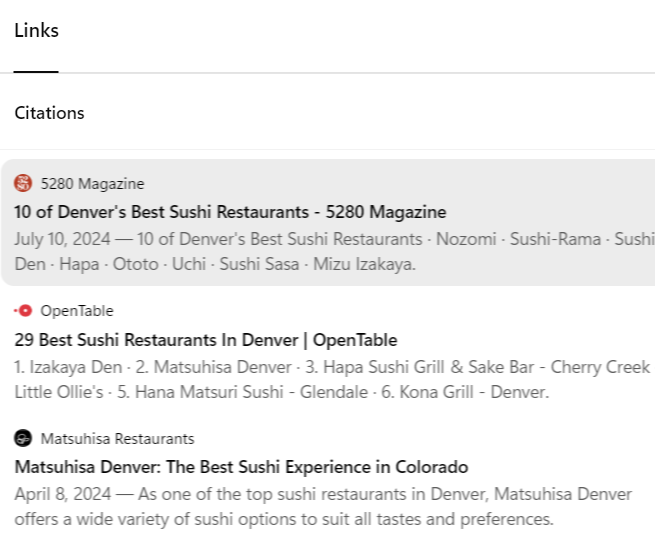
While getting listed on some of these sites requires claiming a local listing, others require getting discovered by a media organization and its team. Discovery can happen organically or through outreach, like offering a complimentary dining experience, product sample, or service tour.
Note: Non-local searches, like for a customer relationship management (CRM) platform that’s best for small teams, focus less on local listings and more on well-known publishers. In this case, ChatGPT cites Zapier and PCMag.
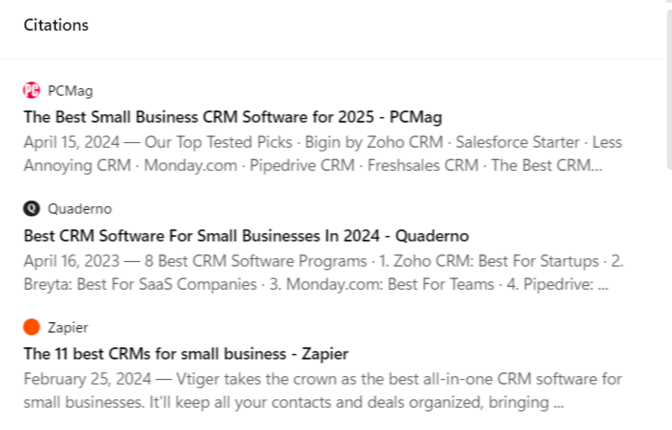
This optimization tactic is similar to traditional or core SEO!
Companies work to build their backlink profile through outreach, which focuses on offering the recipient something of value (like an experience, content, or service) in exchange for consideration or a mention.
4. Optimize content structure
Besides being good for traditional rankings (like on Bing), an optimized content structure also performs well in AI engines like ChatGPT. That’s because headings, lists, and tables make understanding a content’s purpose easy.
Combine this optimized content structure with seamless readability, and it’s another effective tactic for appearing as a ChatGPT source. Take I Heart Naptime’s “Homemade Slime Recipe” page, which ChatGPT cites when searching for slime recipes.

The page includes headings, like the following, to organize its content:
- Slime Ingredients
- How to Make Homemade Slime
- Tips for Making Slime
Plus, I Heart Naptime uses bulleted lists to make following specific sections fast — like the necessary ingredients and tips for making slime — which shows the team understands online users and their target market.
5. Enhance content with E-E-A-T
Trust signals, like the following, can also improve ChatGPT rankings:
- Certifications
- First-hand experiences
- Citations
- Awards
- Author biographies
Remember, people use ChatGPT to get recommendations specific to their situation. They want more than the top accounting software for a small business — they want a reputable platform for a small business in the home services industry that’s generating $X in revenue annually.
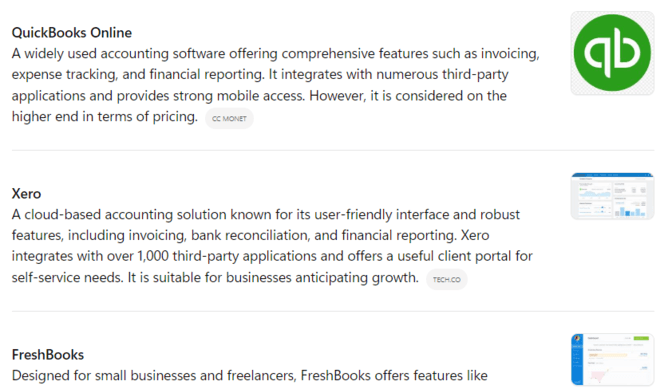
Getting specific and sharing insights based on first-hand experience gives content a competitive edge and outmaneuvers AI-generated content, which is limited to its training data and accessible web data.
6. Use visuals to explain
In some instances, ChatGPT will include visuals in its responses, like the following:

Developing custom visuals for relevant content, whether it’s a photograph, graphic, or video, can get your business discovered in ChatGPT responses (and push back against zero-click searches). In the above example, ChatGPT cites websites like Pinterest, YouTube, and other sites that have invested in visual multimedia.
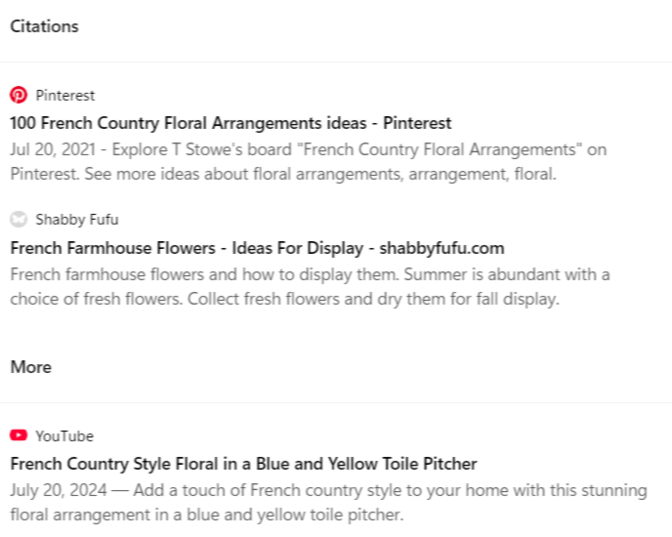
While it’s possible to use AI to generate various multimedia, consider if it’s relevant to the user search. For example, someone looking for flower arrangements might want real arrangements vs. AI-generated ones.
7. Claim local listings
With the platform’s search feature (which could feature ChatGPT ads soon), users can discover places to visit, whether it’s a:
- New restaurant in their local area
- Must-see destination for an upcoming vacation
- Convenient meeting place for a business get-together
ChatGPT uses various sites to generate localized recommendations, including local listings like Yelp. Local listings provide search and answer engines with valuable information about a location, like its address, hours, phone number, reviews, and more.
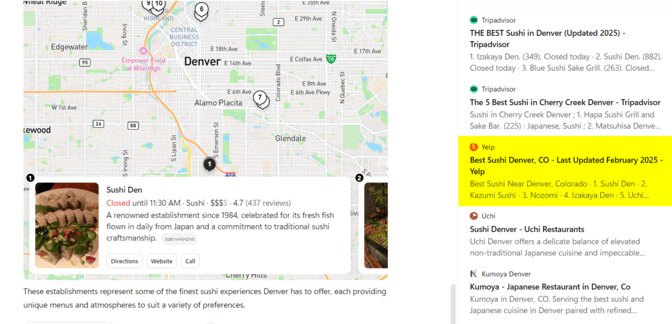
Claim the most prevalent local listings, which include:
- Bing Places
- Yelp
- Google Business Profile
- Apple Maps
Even though ChatGPT uses Bing for its search needs, it’s still worth claiming and optimizing a local listing like Google Business Profile. As the #1 search engine, publishers at other websites (like those writing reviews for the best places to eat in XYZ city) likely use Google to compile options.
Besides this ChatGPT SEO optimization, practice another one related to local SEO: Including your business name, address, and hours on your website. In most cases, businesses place this information on their website footer.

You can discover the ins and outs of local listings in our Local Listings Guide.
How to use ChatGPT to do SEO
Now that you know how to rank in ChatGPT searches, you may wonder if ChatGPT can help you complete these tasks (or others) to help you rank in search results. The answer is yes.
Here’s how you can use ChatGPT to do SEO:
- Keyword research: Use ChatGPT to find keywords, based on your page’s topic, to help you rank for related searches.
- Meta tag generation: ChatGPT can help you create variations of title tags and meta descriptions that you can use to help you pages rank better.
- Schema markup: With ChatGPT, you can create all kinds of schema markup, like FAQ or LocalBusiness, to integrate into your website — schema helps provide context for search and generative engines.
- Content processes: Content creation is a key component of SEO success that ChatGPT can help you do. ChatGPT can help you generate topic ideas, build outlines, and provide keyword suggestions for pages.
- Find third-party sites: ChatGPT can help you local the top affiliate, news, and aggregator sites you can connect with to help you featured on those sites and increase your chances of appearing in ChatGPT results.
How to track ChatGPT rankings
Like other answer engines, tracking ChatGPT rankings isn’t as convenient as tracking rankings in traditional search results on Bing or Google. Instead, businesses use a Microsoft Excel or Google Sheets file to monitor rankings manually.
Companies looking for a more enterprise-level solution can use a paid platform like OmniSEO®. With this platform, businesses can track their (and their competitors’) rankings across platforms, from ChatGPT to Gemini to Perplexity AI.
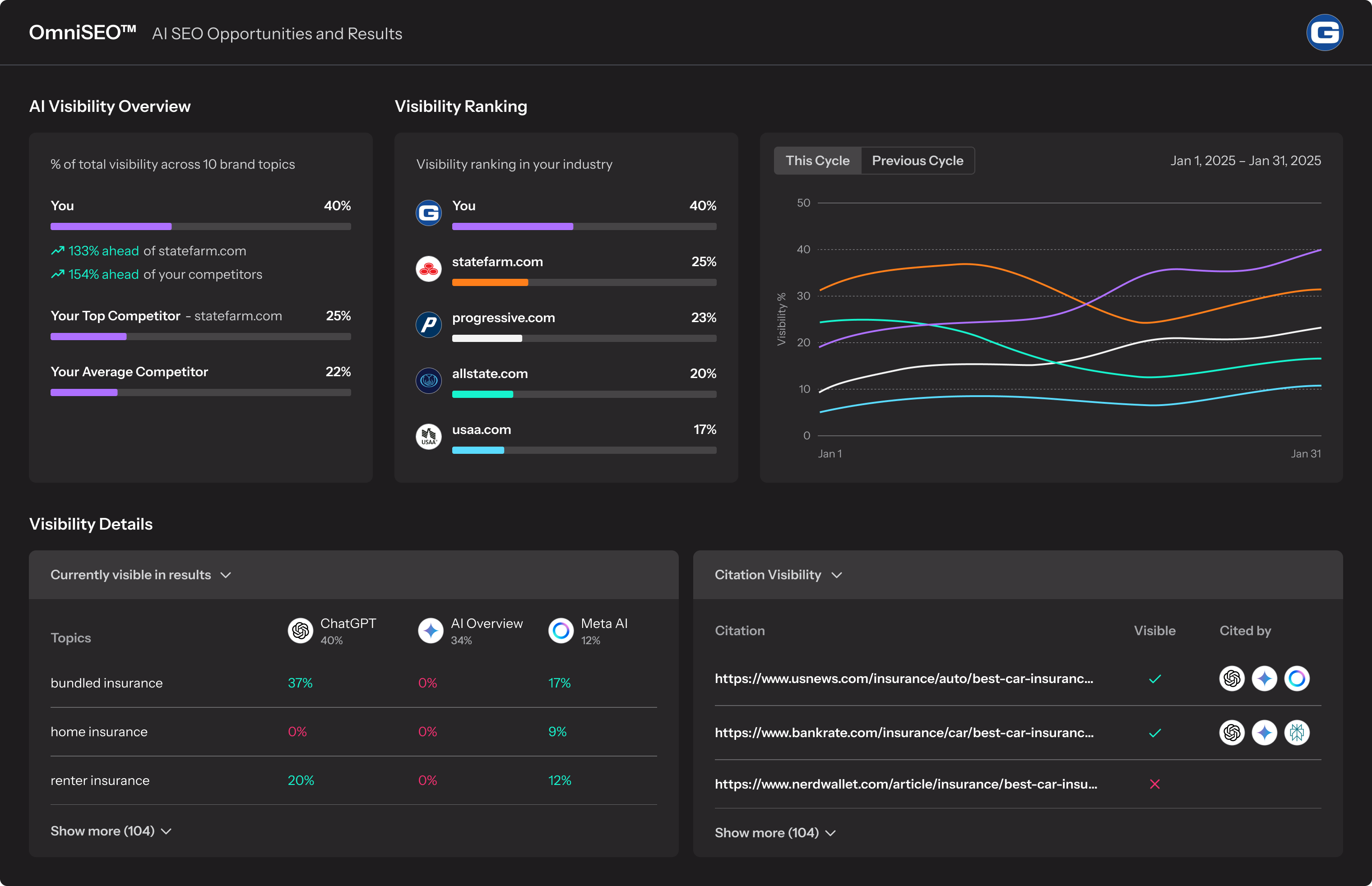
Besides saving teams time, OmniSEO® gives them the data needed to understand, optimize, and improve their AI search performance, which helps the organization scale its performance — and get a competitive advantage in the marketplace.
Get a preview of what our solution can do, try our free AI Overview Checker to find out if your site is appearing in AI results.
Get discovered in ChatGPT with AI SEO
Congrats! You’ve learned the basics of SEO for ChatGPT. Now, you’re ready to start ranking in ChatGPT responses. For professional help, contact us online to receive a custom strategy for optimizing your visibility across ChatGPT, Perplexity AI, and Gemini!

Grow Your Visibility Beyond Google
Capture leads and traffic from emerging search platforms like ChatGPT, Perplexity, and Google AI.

FAQs about ChatGPT and SEO
Get answers to the most common ChatGPT SEO questions below:
How long does SEO for ChatGPT take?
SEO for ChatGPT can take as little as a few weeks or as long as a few months. The duration depends on a brand’s existing SEO. Companies that haven’t practiced (or paused) SEO often see a longer time-to-value (TTV) from ChatGPT SEO than organizations with an established SEO program or work with an AI marketing agency.
Is optimizing for ChatGPT worth it?
Yes! ChatGPT is the most popular AI platform, and it beats Gemini, Perplexity, Claude, and others. Each week, more than 300 million people use the platform, and this number is expected to grow as different generations adopt AI.
Optimizing for ChatGPT now, versus when it’s as integrated into our lives as smartphones, gives your organization a competitive advantage. You’ll have the visibility and understand how to keep your brand discoverable across ChatGPT searches.
Learn more: How to Rank on ChatGPT
How can I use ChatGPT for SEO optimizations?
Besides optimizing for appearing in ChatGPT responses, businesses can also use ChatGPT to streamline SEO processes. Common ChatGPT SEO use cases include generating schema markup, content ideas, competitor research, and more.
Will ChatGPT replace Google Search?
While AI tools like ChatGPT are shaking things up, Google Search isn’t going anywhere. Google’s smart – they’re integrating AI like Gemini to make search even better. We see the future as a blend: the Google you know, powered by AI.
Read: Will AI replace Google Search?

Table of Contents
- How to Rank in ChatGPT
- 1. Practice SEO
- 2. Improve Bing Rankings
- 3. Get Listed on Affiliate, News, and Aggregator Sites
- 4. Optimize Content Structure
- 5. Enhance Content with E-E-A-T
- 6. Use Visuals to Explain
- 7. Claim Local Listings
- Free Guide: How to Get Your Business to Show in Generative AI Tools
- How to Use ChatGPT to Do SEO
- How to Track ChatGPT Rankings
- Get Discovered in ChatGPT with AI SEO
- FAQs About ChatGPT and SEO
- How Long Does SEO for ChatGPT Take?
- Is Optimizing for ChatGPT Worth It?
- How Can I Use ChatGPT for SEO Optimizations?
- Will ChatGPT Replace Google Search?

Grow Your Visibility Beyond Google
Capture leads and traffic from emerging search platforms like ChatGPT, Perplexity, and Google AI.
Writers

Related Resources
- Google AI Mode: What SEOs Need to Know (And Do) Before 2026
- Google Gemini & AI SEO: How to Rank in Gemini’s Answers
- How Do I Get My Products to Be Recommended in ChatGPT?
- How to Appear in ChatGPT Answers: a Guide for Businesses
- How to Rank on Answer Engines: 7 Most Effective Tactics
- How to Use AI in Digital Marketing: Maximize Your Marketing Efforts
- Measuring Success in Omnichannel SEO
- Meet SEO’s New Era: Search Everywhere Optimization
- Meta AI for Business: Understanding Meta Business AI Tools
- What is Omnichannel SEO?


